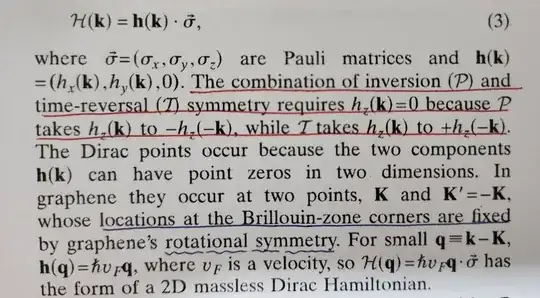I am studying Hasan & Kane's colloquim about topological insulators, and a question has emerged when I reahced the 4th page of this thesis. 1
Passages below the equation (3) show that near the Dirac point, denoted as $K$, the Hamiltonian is $H(\vec{k})=\hbar v_{F}\vec{q}\cdot\vec{σ}$

At first I thought that this is a mere result of Taylor expansion, but some calculations made me realise that this holds only if $\partial_{i}h^{j}(\vec{K})=\hbar v_{F}\delta^{j}_{i}$. However I don't know why this condition can be satisfied. For what reason $\partial_{i}h^{j}(\vec{K})=\hbar v_{F}\delta^{j}_{i}$?
**P.S. "The calculation"
Near $\vec{K}$,
$$
H(\vec{k})=H(\vec{K})+\vec{q}\cdot\nabla_{\vec{k}}H(\vec{K})=\sigma_{j}h^{j}(\vec{K})+q^{i}\partial_{i}(\sigma_{j}h^{j})(\vec{K})=0+\sigma_{j}q^{i}\partial_{i}h^{j}(\vec{K})
$$
$$
\hbar v_{F}\vec{q}\cdot\vec{\sigma}=\hbar v_{F}q^{j}\sigma_{j}
$$
$$
\hbar v_{F}q^{j}\sigma_{j}=\sigma_{j}q^{i}\partial_{i}h^{j}(\vec{K}) \Rightarrow \partial_{i}h^{j}(\vec{K})=\hbar v_{F}\delta^{j}_{i}
$$